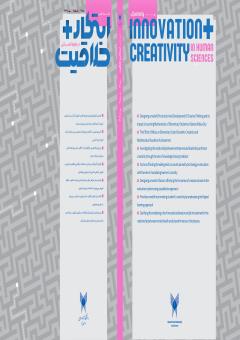طراحی الگوی آموزش و توسعه تفکر خلاق و تأثیر آن بر یادگیری ریاضی دانش آموزان دوره ابتدایی شهر بندرعباس
محورهای موضوعی : روش‏ها و فنون خلاقیت و نوآوری، مهندسی خلاقیت و نوآوری
1 - استادیار گروه آموزش ریاضی، دانشگاه فرهنگیان، تهران، ایران
کلید واژه: واژه های کلیدی:آموزش تفکر خلاق, یادگیری, ارتباط برقرار کردن, تجربه کردن, ,
چکیده مقاله :
زمینه:تغییر و توسعه روز افزون فناوری، نظام های آموزشی را تحت تاثیر قرار داده و برای هماهنگی با این تغییرات معلمان باید در روش های آموزشی خود تجدید نظر کنند. باید روش هایی را به کار گیرند که فراگیرندگان را به تفکر وا دارند و به سوی اندیشه ورزی سوق دهند. بهبود و ارتقاء تفکر خلاق در دانشآموزان، بهعنوان یکی از مهارتهای مورد نیاز عصر ارتباطات، مستلزم تناسب و بهکارگیری الگوها و روشهای طراحی آموزشی نوین است . هدف: هدف این پژوهش، طراحی الگوی آموزش و توسعه تفکر خلاق و تأثیر آن بر یادگیری ریاضی دانشآموزان دوره ابتدایی شهر بندرعباس است. روش: طرح پژوهش نیمه آزمایشی از نوع پیش آزمون- پس آزمون با گروه کنترل بود. جامعه آماری ، شامل کلیه دانشآموزان دختر پایه چهارم ابتدایی شهر بندرعباس در سال تحصیلی 1399-1400بود. نمونه پژوهش شامل 60 دانش آموز دختر بود که با روش نمونه گیری خوشه ای چند مرحله ای انتخاب شدند و بهصورت تصادفی در دو کلاس 30 نفره آزمایش و کنترل جایگزین شدند. دانش آموزان گروه آزمایش به مدت 8 جلسه 45 دقیقه ای به مدت 6 هفته الگوی آموزش مهارت تفکر خلاق بر اساس استراتژی REACT ( کراوفورد ،2001) برای مبحث کسر(جمع وتفریق و ضرب و تقسیم ) و اعداد اعشاری( تقسیم ) را دریافت کردند و دانش آموزان گروه کنترل تحت این آموزش قرار نگرفتند. ابزار اندازه گیری پیشآزمون و پسآزمون ، آزمون استاندارد ریاضی پایه چهارم که از نمونه سؤالات امتحانی مورد تائید آموزشوپرورش شهر بندرعباس بود استفاده شد. یافته ها: نتایج تحلیل کواریانس چند متغیره نشان داد تفاوت معناداری بین گروه آزمایش و کنترل دراجرای الگوی آموزش و توسعه تفکر خلاق بر یادگیری ریاضی دانش آموزان و مولفه های تفکر خلاق در مرحله پس آزمون وجود دارد (p>0/05). نتیجه گیری: همچنین نتایج نشان داد که کلاس درس در الگوی آموزش توسعه تفکر خلاق در مقایسه با کلاس درس سنتی، موجب اثر گذاری مثبت بیشتری بر میزان یادگیری ریاضی دانش آموزان شده است.
Background: The changing and increasing development of technology has affected the educational systems, and to coordinate with these changes, teachers must reconsider their teaching methods. They should use methods that make learners think and lead them to thinking. Improving and promoting creative thinking in students, as one of the skills needed in the age of communication, requires the appropriateness and application of new educational design patterns and methods. Purpose: The purpose of this research is to design a teaching model and develop creative thinking and its effect on the mathematical learning of elementary school students in Bandar Abbas city. Method: The research design was a semi-experimental pre-test-post-test type with a control group. The statistical population included all female students in the fourth grade of Bandar Abbas city in the academic year of 2014-2016.The research sample included 60 female students who were selected by multi-stage cluster sampling method and were randomly replaced in two classes of 30 students, experimental and control. The students of the experimental group received the creative thinking skill training model based on the REACT strategy (Crawford, 2001) for the subject of fractions (addition, subtraction, multiplication and division) and decimal numbers (division) for 8 sessions of 45 minutes for 6 weeks. The students of the control group were not subjected to this training. The pre-test and post-test measurement tools were the fourth grade standard math test, which was a sample of exam questions approved by Bandar Abbas Education. Findings: The results of multivariate covariance analysis showed that there is a significant difference between the experimental and control groups in the implementation of the model of teaching and development of creative thinking on students' mathematical learning and the components of creative thinking in the post-test stage (p>0.05).Conclusion: Also, the results showed that the classroom in the teaching model of creative thinking development, compared to the traditional classroom, had a more positive effect on the amount of students' mathematical learning

